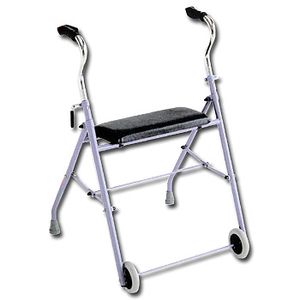Walkers: Difference between revisions
No edit summary |
No edit summary |
||
| Line 39: | Line 39: | ||
* keep close to the frame at all times, near the back wheels | * keep close to the frame at all times, near the back wheels | ||
* for downhill ramp use gently squeeze on brakes at all times | * for downhill ramp use gently squeeze on brakes at all times | ||
* ensure that brakes are locked before sitting on the seat of frame, with frame on level ground, preferably with wall or fence behind. | * ensure that brakes are locked before sitting on the seat of frame, with frame on level ground, preferably with wall or fence behind.<ref>Government of South Australia. Department for communities and social services. January 2013. Available from https://www.des.sa.gov.au/_data/assets/word_doc/0011/19595/4-wheeled-walkers-fact-sheet.doc Last accessed 17/2/2019</ref> | ||
== References == | == References == | ||
Revision as of 00:53, 17 February 2019
Original Editor - The Open Physio project.
Top Contributors - Lucinda hampton, Lauren Lopez, Admin, Jess Bell, Kim Jackson, Jeremy Bryan, Rachael Lowe, Abbey Wright, Larisa Hoffman, Robin Tacchetti, Ammar Suhail, WikiSysop, Redisha Jakibanjar and Naomi O'Reilly
Introduction[edit | edit source]
A walker is a walking aid that has four points of contact with the ground and usually has three sides with the side closest to the patient being open. It provides a wider base of support than a walking stick and so is used more to stabilise patients with poor balance.
Types of Walkers [edit | edit source]
Many walkers exists on the market and a physiotherapist is well placed to be instrumental in choosing the correct walker for the differing needs of clients.
- Wheels on all four legs, with or without brakes. Many variations exist in the designs of the walkers eg hards seat, material seats, carry baskets/bags, push down brakes, grip on brakes, large wheels for outdoors, small wheels for indoors, carbon fibre light weight for easy lifting into cars. All variations should be taken into account so the most suitable one is chosen for a particular persons needs. A large sturdy forearm support 4 wheels walker also exists for those needy extra stability.
- Two front legs with two rear casters
- Two front legs and two rear wheels with brakes which operate on downward pressure on the wheels
- "Square" wheels
- Ability to be folded, which makes travelling with the frame easier
- Trays, seats and baskets may be attached
- Other modifications such as a light that projects a red line on the ground in order to guide step length in individuals with Parkinsons
Usage[edit | edit source]
Walkers should be adjustable in height, which is measured in the same way as one would measure for a walking stick.
never attempt to use a frame to help you sit or stand
A frame with four legs and a wide base, known as a Zimmer frame is used in the following way if WB on both legs.The patient:
- Picks it up
- Moves it forwards
- Places it in front of them
- Leans on the frame, taking weight through the upper limbs
- Walks into it (the patient should be encouraged to take two small, even steps to avoid a disordered gait pattern)
A 4 wheeled walker
- make sure walker is completely opened and hinges locked
- keep close to the frame at all times, near the back wheels
- for downhill ramp use gently squeeze on brakes at all times
- ensure that brakes are locked before sitting on the seat of frame, with frame on level ground, preferably with wall or fence behind.[2]
References[edit | edit source]
- ↑ Reviews vid. Best walkers 2018-best rollator walkers with a seat. Available from: https://www.youtube.com/watch?v=azig88E770k&feature=youtu.be [last accessed 16/2/2019]
- ↑ Government of South Australia. Department for communities and social services. January 2013. Available from https://www.des.sa.gov.au/_data/assets/word_doc/0011/19595/4-wheeled-walkers-fact-sheet.doc Last accessed 17/2/2019







